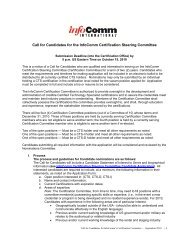Building Information Modeling (BIM) - InfoComm International
Building Information Modeling (BIM) - InfoComm International
Building Information Modeling (BIM) - InfoComm International
Create successful ePaper yourself
Turn your PDF publications into a flip-book with our unique Google optimized e-Paper software.
16<br />
Once the aforementioned analyses have taken place, the next step is to develop an overall phased strategy for<br />
implementation. The implementation should include:<br />
Timeline<br />
A detailed timeline is required to ensure that the overall strategy is being implemented in a timely and organized<br />
process.<br />
Personnel Changes<br />
A change to a <strong>BIM</strong> delivery process represents a big change to an existing CAD workflow and thus a change to<br />
individual employee roles. The biggest change is a move away from pure drafters. With the <strong>BIM</strong> process focused<br />
around building a project in the virtual environment, those who are interacting with the model require more trade<br />
knowledge to be efficient.<br />
Generally speaking, two new roles will be defined within the organization: a company <strong>BIM</strong> manager and project<br />
<strong>BIM</strong> managers. A company <strong>BIM</strong> manager will lead the charge for the company and be the guiding force behind<br />
implementation, standards development and software decisions. On each project, a project <strong>BIM</strong> manager should<br />
be assigned who is responsible for project-related <strong>BIM</strong> decisions, interacting with other project team members,<br />
<strong>BIM</strong> managers and maintenance of the model.<br />
Training Plan<br />
Training on a <strong>BIM</strong> platform is best completed using a “Just in Time” method. A lot of the concepts involved with<br />
<strong>BIM</strong> are very different when compared with a traditional CAD workflow and therefore are best learned working<br />
on an actual project. A proven method of success is to have multiple training days consisting of half a day for<br />
classroom instruction followed by half a day of actual project work with the instructor available for hands-on<br />
teaching. Training should start with only a small group of employees on a single project so that they can help<br />
streamline the <strong>BIM</strong> workflow prior to getting the entire organization up to speed.<br />
It is also advantageous for at least a single employee to receive in-depth training and then act as the <strong>BIM</strong> manager<br />
for the company. This person can then be the “go-to person” for help and can lead the establishment of standards.<br />
Keys to Success<br />
Successful <strong>BIM</strong> implementation within a company starts with the shared vision of change and buy-in from all<br />
members of the organization. Senior leadership needs to support the change and be willing to sacrifice a little in<br />
the beginning to reap the future rewards.<br />
Other organizations are at all stages of the <strong>BIM</strong> implementation process - from thinking about it, starting to<br />
implement and fully operating in a <strong>BIM</strong> workflow. Additionally, there are many local and regional <strong>BIM</strong> and IPD<br />
groups that meet on a regular basis to discuss <strong>BIM</strong>-related topics. It is important to network with industry peers to<br />
share successes and failures to help better the industry as a whole.<br />
The key to success in any <strong>BIM</strong> project is collaborative effort among all team members, which includes but is<br />
not limited to the project owner, the design team, general contractor, subcontractors and vendors/suppliers.<br />
<strong>Information</strong> data must flow freely between all of the <strong>BIM</strong> project team members to obtain maximum advantages in<br />
a <strong>BIM</strong> project. The project owner plays a central role in leading the discussion and decision-making process when<br />
it comes to applying <strong>BIM</strong> to his/her project.<br />
Use available <strong>BIM</strong> resources to further understand of more advanced <strong>BIM</strong> concepts and practice. Set aside<br />
enough resources to ensure that your organization is not just buying software but is engaging in a business<br />
process that will meet your current and future business needs and opportunities.<br />
With an intelligent implementation of <strong>BIM</strong> technology, your team starts to develop skills and techniques, build<br />
confidence in the software and pace the future work for potential benefits. For your organization it will mean new<br />
opportunities to provide the highest level of product.

















